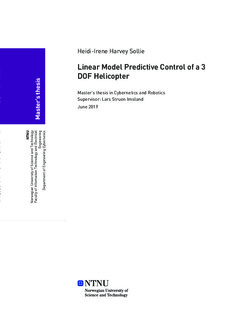| dc.contributor.advisor | Imsland, Lars Struen | |
| dc.contributor.author | Sollie, Heidi-Irene Harvey | |
| dc.date.accessioned | 2019-10-31T15:07:30Z | |
| dc.date.issued | 2019 | |
| dc.identifier | no.ntnu:inspera:35771502:18581862 | |
| dc.identifier.uri | http://hdl.handle.net/11250/2625704 | |
| dc.description.abstract | Denne oppgaven presenterer implementasjonen av lineær modellprediktiv regulering (MPR) av et modellhelikopter med tre frihetsgrader, der pitch og høyden til helikopteret er brukt som pådrag for å styre systemet til likevektspunktet fra et vilkårlig startpunkt. En pitch-regulator (PD) og høyde-regulator (PID) utgjør det laveste nivået av reguleringsarkitekturen.
En ulineær modell av helikopterdynamikken er utviklet og linearisert rundt likevektspunktet, og uttrykt i tilstandsromrepresentasjon. Hele reguleringsarkitekturen, i tillegg til C-biblioteket til QP-løseren, er implementert i Simulink. Sanntidsprogramvaren QUARC kombinert med kodegenerasjonsegenskapene til Simulink gjør det mulig for denne modellen å kjøre direkte på I/O-kortet som styrer helikopteret.
Lineær MPR med og uten terminalkostnad og terminalbeskrankning presenteres først i en numerisk simulering av helikoptermodellen og deretter på det fysiske helikopteret. Videre er en konstant forstyrrelse på helikopteret modellert, og et Kalmanfilter er implementert for å fjerne avviket denne driften forårsaker.
Først og fremst er denne oppgaven en testimplementasion av modellprediktiv regulering på et dynamisk helikopter med tre frihetsgrader. Det er demonstrert at bruk av MPR for et slikt dynamisk system er mulig med nye QP-løsere og moderne teknologi. QP-løseren utfører optimalseringsberegninger i sanntid med en gjennomsnittlig løsetid på rundt 30 millisekunder, noe som er hyppig nok til å sørge for stabil kontroll. | |
| dc.description.abstract | This thesis presents the implementation of linear model predictive control of a model helicopter with three degrees of freedom (DOF). It is a bench-top model of a propeller-actuated helicopter where the pitch (roll) and elevation (vertical) of the helicopter are used as control inputs to steer the system to its equilibrium from an arbitrary starting point in travel (yaw). A pitch controller (PD) and elevation controller (PID) make up the lower level of control.
A nonlinear model of the helicopter dynamics is developed and linearized to state-space representation. The entire control architecture, along with the C library for the QP solver, is implemented in Simulink. The real-time control software QUARC combined with the code generation capabilities of Simulink, allows for this model being run on the I/O board connected to the helicopter.
Linear MPC with and without a terminal cost and terminal constraint is presented, first in a numerical simulation of the linearized model and then on the physical helicopter. Furthermore, a known constant drift of the helicopter is modeled and a Kalman filter is implemented to remove the constant offset in travel that this drift causes.
First and foremost, this thesis is proof-of-concept for the model predictive control of a dynamic 3 DOF helicopter. It is demonstrated that using MPC for such a dynamic system is possible with modern QP solvers and advanced embedded hardware. The QP solver performs the online computation with an average solve time of about 30 milliseconds, which is frequent enough for stable control. | |
| dc.language | eng | |
| dc.publisher | NTNU | |
| dc.title | Linear Model Predictive Control of a 3 DOF Helicopter | |
| dc.type | Master thesis | |
